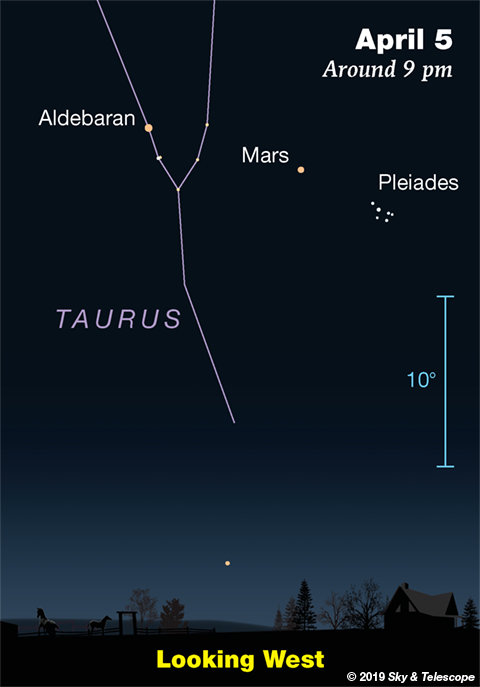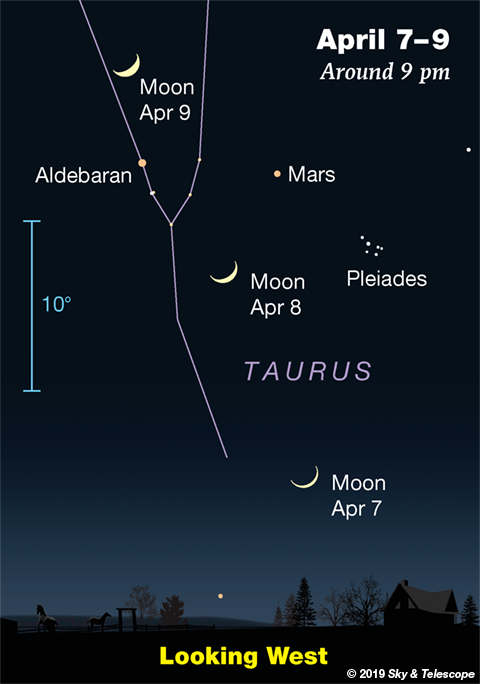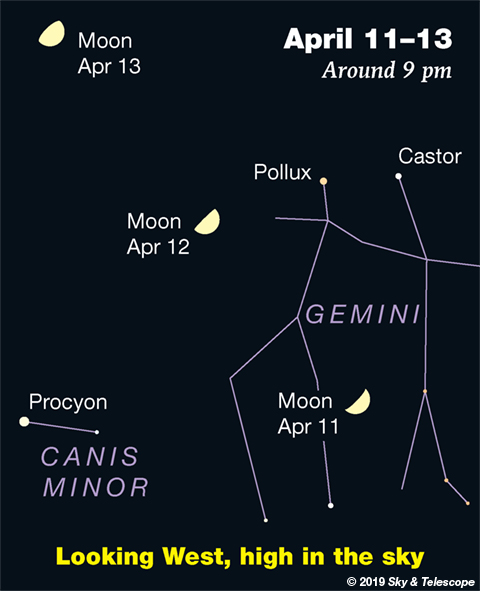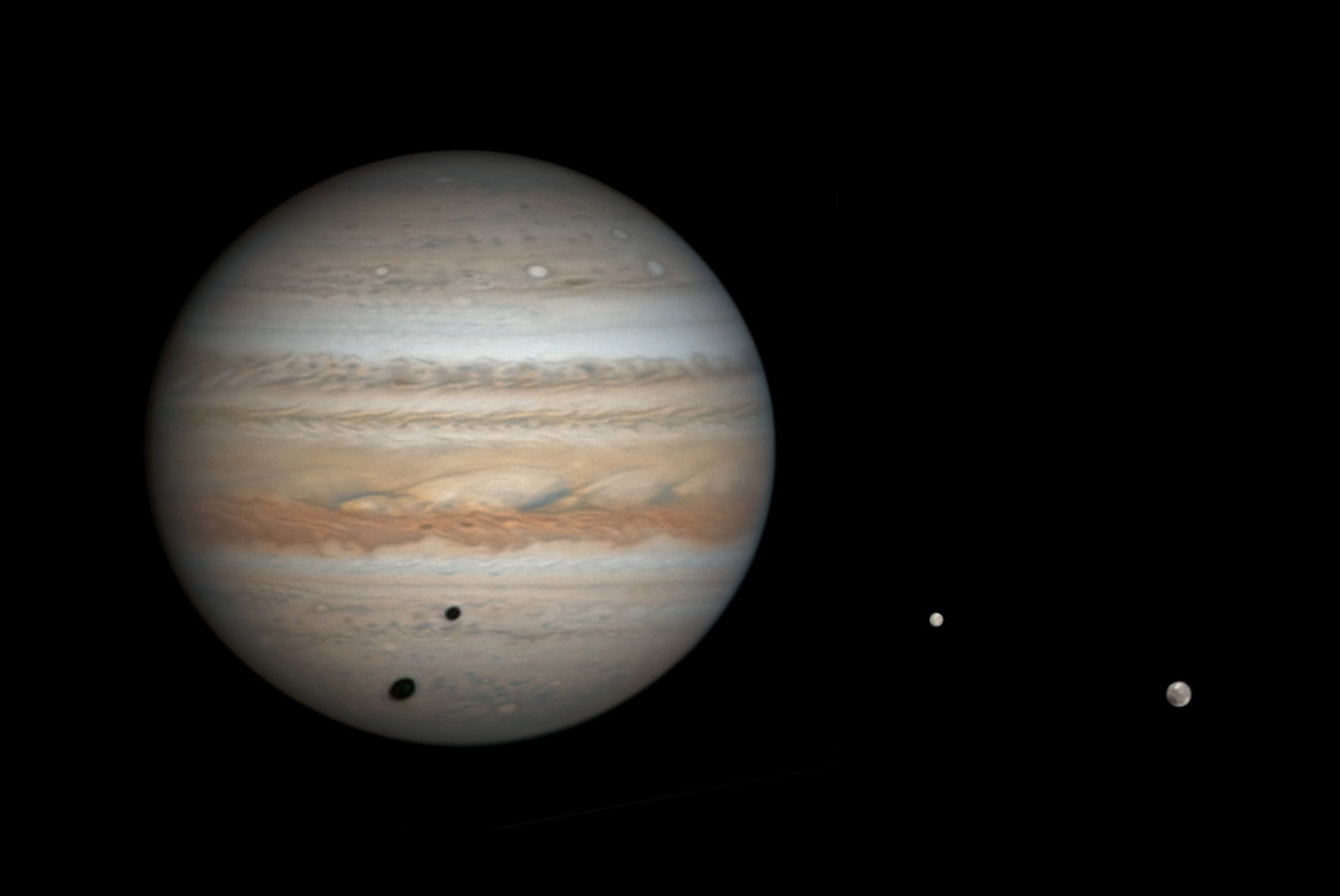


Friday, April 5
• Shortly after the end of twilight at this time of year, Arcturus, the bright Spring Star climbing in the east, stands just as high as Sirius, the brighter Winter Star, has descended to in the southwest (for viewers at mid-northern latitudes).
These are the two brightest stars in the sky at the time. But Capella is a very close runner-up to Arcturus! Spot it high in the northwest.
• New Moon (exact at 3:50 a.m. on this date EDT).
Saturday, April 6
• The asteroid 2 Pallas is at opposition and detectable in good binoculars at magnitude 7.9 (the same brightness as Neptune). It's 4° from Arcturus tonight, on its way to passing just 0.05° north of Eta Bootis on the evening of April 10th.
And, smaller 7 Iris is also about at opposition. It's farther south in Corvus and only magnitude 9.4. See Bob King's Pop In on Pallas and Iris Tonight, with finder charts.
Sunday, April 7
• As dusk turns into night, the thin crescent Moon shines down below the arc of Aldebaran, Mars and the Pleiades, as shown here.
• High over the Big Dipper late these evenings, nearly crossing the zenith, are three pairs of dim naked-eye stars, all 3rd or 4th magnitude, marking the Great Bear's feet. They're also known as the Three Leaps of the Gazelle, from early Arab lore. They form a long line roughly midway between the bowl of the Big Dipper and the Sickle of Leo; see the evening constellation chart in the center of the April Sky & Telescope.
According to the Arabian story, the gazelle was drinking at a pond — the big, dim Coma Berenices star cluster — and bounded away when startled by a flick of Leo's nearby tail, Denebola. Leo, however, seems quite unaware, facing the other way.
Monday, April 8
• The huge bright Winter Hexagon still fills the sky to the southwest and west right after dusk. Start with brilliant Sirius in the southwest, the Hexagon's lower left corner. High above Sirius is Procyon. From there look even higher for Pollux and Castor, rightward from Castor to Menkalinan and bright Capella, lower left from there to Aldebaran (by the Moon), lower left to Rigel at the bottom of Orion, and back to Sirius.
Tuesday, April 9
• Now the Moon shines over Aldebaran after dark, as shown above.
• This is the time of year when, as the last of twilight fades away, the bowl of the dim Little Dipper extends straight to the right of Polaris. High above the end-stars of the Little Dipper's bowl, you'll find the end-stars of the Big Dipper's bowl.
Wednesday, April 10
• Vega, the bright "Summer Star," rises in the northeast late these evenings. Exactly where should you watch for it to come up? Spot the Big Dipper almost overhead in the northeast. Look at Mizar at the bend of its handle. If you can see Mizar's tiny, close companion Alcor (binoculars make it easy), follow a line from Mizar through Alcor all the way down to the horizon. That's where Vega makes its appearance.
• This evening for North America, the asteroid 2 Pallas, magnitude 7.9, is passing 3 or 4 arcminutes north of Eta (η) Bootis, magnitude 2.6. See Pop In on Pallas and Iris Tonight.
Thursday, April 11
• Mars is passing less than 7° of Aldebaran from now through April 18th. (It's to Aldebaran's right this evening, and to Aldebaran's upper right later in the week.)
Friday, April 12
• First-quarter Moon (exactly so at 3:06 p.m. EDT). Come evening, the Moon shines high in the southwest with Pollux and Castor to its upper right and brighter Procyon farther below it, as shown above. Far below Procyon sparkles Sirius, the brightest star of all.
Saturday, April 13
• Use binoculars to look for M44, the scattery Beehive Star Cluster in Cancer, roughly 3° to the right of the glary Moon (as seen soon after dark from the longitudes of North America).
________________________
Want to become a better astronomer? Learn your way around the constellations. They're the key to locating everything fainter and deeper to hunt with binoculars or a telescope.
This is an outdoor nature hobby. For an easy-to-use constellation guide covering the whole evening sky, use the big monthly map in the center of each issue of Sky & Telescope, the essential guide to astronomy.

Once you get a telescope, to put it to good use you'll need a detailed, large-scale sky atlas (set of charts). The basic standard is the Pocket Sky Atlas (in either the original or Jumbo Edition), which shows stars to magnitude 7.6.
Next up is the larger and deeper Sky Atlas 2000.0, plotting stars to magnitude 8.5; nearly three times as many. The next up, once you know your way around, are the even larger Interstellarum atlas (stars to magnitude 9.5) and Uranometria 2000.0 (stars to magnitude 9.75). And read how to use sky charts with a telescope.
You'll also want a good deep-sky guidebook, such as Sue French's Deep-Sky Wonders collection (which includes its own charts), Sky Atlas 2000.0 Companion by Strong and Sinnott, or the bigger Night Sky Observer's Guide by Kepple and Sanner.
Can a computerized telescope replace charts? Not for beginners, I don't think, and not on mounts and tripods that are less than top-quality mechanically (meaning heavy and expensive). And as Terence Dickinson and Alan Dyer say in their Backyard Astronomer's Guide, "A full appreciation of the universe cannot come without developing the skills to find things in the sky and understanding how the sky works. This knowledge comes only by spending time under the stars with star maps in hand."

A Venus-Mercury challenge. Venus (magnitude –3.9) and much fainter Mercury (about magnitude +0.4) are both very low in the brightening dawn. Pick up Venus near the east horizon about 20 or 25 minutes before sunrise. Then use binoculars or a wide-field telescope to look for little Mercury to its lower left. They're separated by 6½° on the morning of April 6th, shrinking to 4½° by the 13th.
Mars (magnitude +1.5, in Taurus) glows in the west after dusk. Start with Orion in the west-southwest, and look to the right from there for the orange pair of Aldebaran and Mars. Mars is the one on the right, slightly fainter. Spot the Pleiades to the lower right of Mars, farther from it each evening.
Jupiter (magnitude –2.3, in the feet of Ophiuchus) rises in the southeast around midnight or 1 a.m. daylight-saving time. It shines fairly high in the south before the beginning of dawn, so that's the best time to observe it telescopically. Get set up about two hours before your local sunrise.
By that time you'll also find Antares to Jupiter's lower right, and the dimmer Sagittarius Teapot to Jupiter's lower left.
In addition, Saturn (magnitude +0.6, in Sagittarius) will be glowing to the left or lower left of Jupiter at the beginning of dawn. They're 26° apart.
Uranus and Neptune are out of sight behind the glare of the Sun.
______________________
All descriptions that relate to your horizon — including the words up, down, right, and left — are written for the world's mid-northern latitudes. Descriptions that also depend on longitude (mainly Moon positions) are for North America.
Eastern Daylight Time (EDT) is Universal Time (UT or GMT) minus 4 hours.
______________________
Audio sky tour. Out under the evening sky with your earbuds in place, listen to Kelly Beatty's monthly podcast tour of the heavens above. It's free.
______________________
"I seem to have been only like a boy playing on the seashore, and diverting myself in now and then finding a smoother pebble or a prettier shell than ordinary, whilst the great ocean of truth lay all undiscovered before me."
— Isaac Newton, 1642–1727
______________________
 7
7








Comments
Rod
April 5, 2019 at 1:45 pm
mary beth, how is the stargazing in Houston? "Saturday, April 6• The asteroid 2 Pallas is at opposition..." I did observe Pallas on 03-April-19 near 2300 EDT. I posted an observation note on Bob King's report. Weather hear lately cloudy, drizzle and some light rain (means plenty of grass cutting and weed whacking). I may not be able to view Pallas again for a while here.
You must be logged in to post a comment.
mary beth
April 5, 2019 at 3:09 pm
Hi Rod... not too much activity here but I am looking forward to seeing Vega! Also the conjunction of Mars and Aldebaran should be very pretty Do you know what day they will be closest together?. Our weather is supposed to get nice starting Monday but will have strong storms from now till then. I will definitely update you during the week. Hope you have good weather soon. Sorry you’ve had clouds and lots of yard work to do....
You must be logged in to post a comment.
Rod
April 5, 2019 at 3:52 pm
mary beth, sound like some stargazing will be on the way for you. Mars and Aldebaran -"Thursday, April 11• Mars is passing less than 7° of Aldebaran from now through April 18th. (It's to Aldebaran's right this evening, and to Aldebaran's upper right later in the week.)" For your location in Houston, 11th of April looks to be the closet for these two. Sunsets near 7:45 PM at Houston, Aldebaran in Taurus at 8:30 PM will be 35 degrees altitude and 269 degrees azimuth in your area. Mars and Aldebaran will be 6 degrees, 49' angular separation then near the ecliptic. Comparing apparent magnitudes, Aldebaran will be 0.53 brighter than Mars 🙂 Plenty of outdoor work comes with rural, small and large farm living. It will soon be turkey season here 🙂
You must be logged in to post a comment.
Rod
April 5, 2019 at 4:01 pm
oops, Aldebaran is mv +0.84, Mars mv +1.52 so Aldebaran is 1.87x brighter than Mars using Jean Meeus formula.
You must be logged in to post a comment.
mary beth
April 6, 2019 at 1:12 am
Thank you for all that information! I will definitely be watching that on the 11th. It is amazing that Aldebaran will be that much brighter I have a very good view of the western sky so it should be very easy to see! I will keep you posted on everything… Strong storms Saturday and Sunday before the clearing on Monday. Enjoy the outdoors, I wonderful time of year!
You must be logged in to post a comment.
mary beth
April 9, 2019 at 1:36 pm
I saw Spica last night.....There is a group of tall trees in the SE corner of the neighborhood but I finally had clear skies and could ‘arc to Arcturus and speed on to Spica’ last night. So Springy! Crescent moon was amazing, saw it very low in the west til it disappeared below the rooflines. Mars dim but still made a pretty triangle with moon and sparkly Aldebaran.
You must be logged in to post a comment.
Rod
April 9, 2019 at 3:09 pm
Very good 🙂 Plenty of clouds and at times, light rain here. Today mostly cloudy skies and perhaps better viewing tomorrow. Early morning yesterday (before more clouds and light rain developed) near 0830 local I was able to briefly view a new, large sunspot that appeared on the Sun on Sunday. As the Sun rotates, the large sunspot became visible to Earth viewers like me as it rotated into view 🙂 It is AR2738.
You must be logged in to post a comment.
You must be logged in to post a comment.